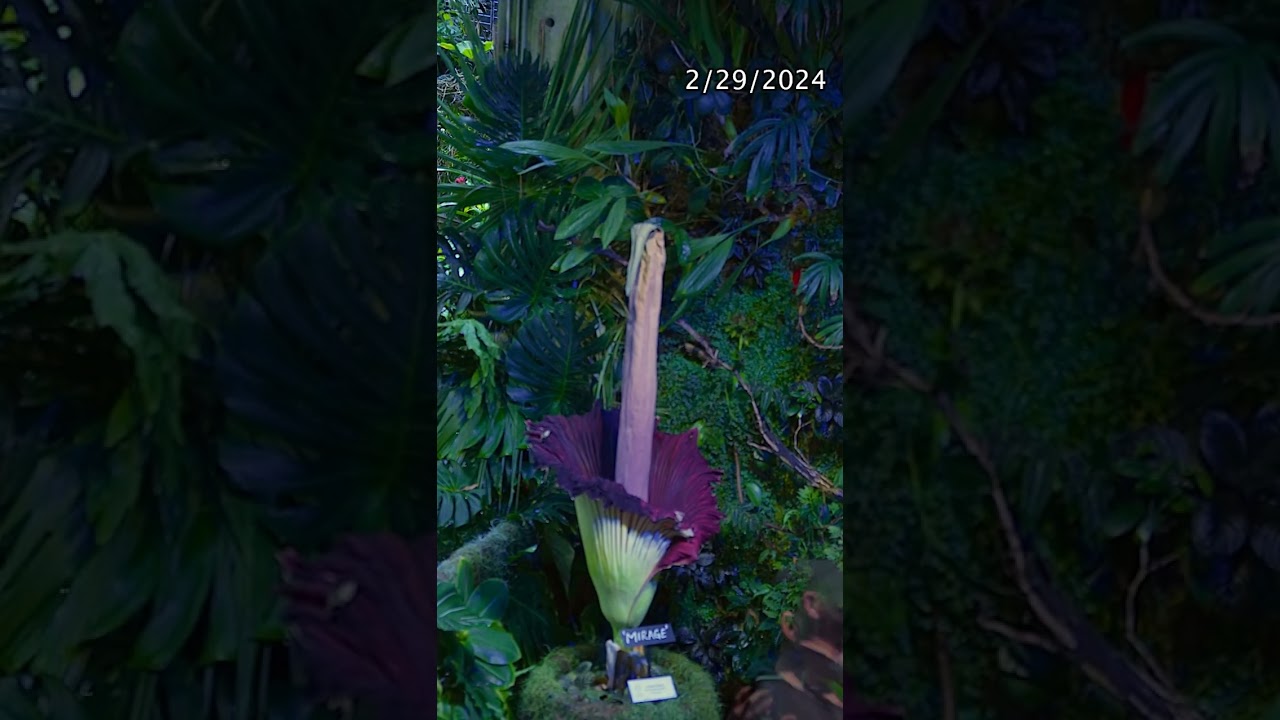– The biology and lifecycle of the corpse flower, including its infrequent blooming cycle.
– Conservation efforts for the corpse flower and the importance of botanical gardens in preserving rare plant species.
– The role of zoos and botanical gardens in education and promoting interest in plant and wildlife conservation.
– The sensory experience of witnessing a corpse flower bloom and the scientific interest it generates.
The corpse flower, scientifically known as Amorphophallus titanum, is one of the most fascinating and rare blooming plants observed in the botanical world. It captivates spectators not just because of its immense size but also because of its peculiar method of pollination and infrequent blooming cycle, which sometimes lasts over a decade.
Habitat loss and environmental changes pose significant threats to the corpse flower in the wild, making conservation efforts crucial for its survival. Botanical gardens worldwide, such as the one home to Mirage, play a key role in these conservation efforts. They cultivate these plants under controlled conditions, which not only aids in their preservation but also provides a unique opportunity for public education and engagement in conservation issues.
These institutions, including zoos and botanical gardens, serve as crucial educational platforms. They allow the public to experience rare natural phenomena, such as the blooming of the corpse flower, firsthand. This direct engagement fosters a more profound interest in and understanding of the importance of plant and wildlife conservation. Education programs connected with events like Mirage’s Bloom help demystify scientific knowledge, making it more accessible and engaging to a broad audience.
Like others, watching Mirage, the corpse flower, go through its bloom cycle is a sensory experience. Its name comes from the rotting flesh odor it emits during its fleeting bloom, a strategy to attract pollinators like carrion beetles and flesh flies. This peculiar characteristic and its rare and unpredictable flowering create a significant buzz and draw large crowds to witness the event. The spectacle provides an invaluable opportunity to generate public interest in plant biology and the importance of conservation.
The scientific community also greatly benefits from these events. Each bloom allows researchers to study its lifecycle and pollination strategy further, contributing to a better understanding of rare plant species’ survival mechanisms. This knowledge is crucial for developing effective conservation strategies in botanical gardens and the flower’s natural habitat.
The public plays a vital role in conservation efforts by supporting and visiting botanical gardens that are home to plants like the corpse flower. These visits contribute to the funding and attention necessary for the gardens to continue their vital work in plant preservation and environmental education. Additionally, witnessing events like the bloom of Mirage offers a unique opportunity to connect with the natural world, fostering a deeper appreciation for its complexity and the importance of preserving its diversity.
Zoos and botanical gardens’ ability to bring rare and fascinating instances of nature to the public eye, such as the Bloom of Mirage, underlines the importance of these institutions in conservation and education. They provide a sanctuary for rare species and serve as a bridge between scientific research and public engagement, contributing significantly to the global efforts to preserve our natural world for future generations. Through events like the blooming of corpse flowers, these institutions continue to inspire and educate the public about the wonders of the natural world and the critical need for its conservation.
*****
Source Description
Mirage was only in bloom for about 3 days last month, but the stench will be sealed in our memories forever. Corpse flower blooms happen once every few years, and we’re already looking forward to the next time we’re lucky enough to experience this rare event. Did you see (and smell) Mirage in action during this first bloom?
– – –
🙌 Now More Than Ever, We Need Your Support
The Academy has a new mission: to regenerate the natural world through science, learning and collaboration. Please consider donating to https://bit.ly/3JcOewJ — any amount helps. Thank you!
– – –
The California Academy of Sciences is a renowned scientific and educational institution dedicated to regenerating the natural world through science, learning, and collaboration. Based in San Francisco’s Golden Gate Park, it’s the only place in the world to house an aquarium, planetarium, rainforest, natural history museum, and cutting-edge research programs all under one living roof.
Connect with us:
• Facebook: https://facebook.com/calacademy
• Twitter: https://twitter.com/calacademy
• Instagram: https://instagram.com/calacademy

